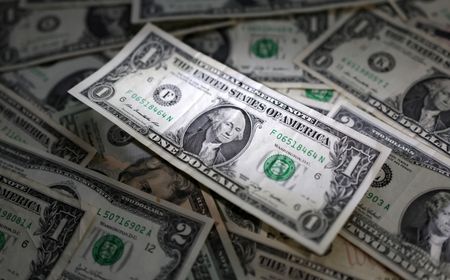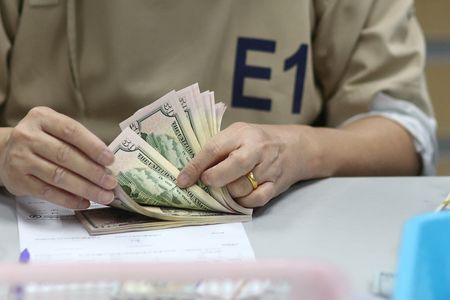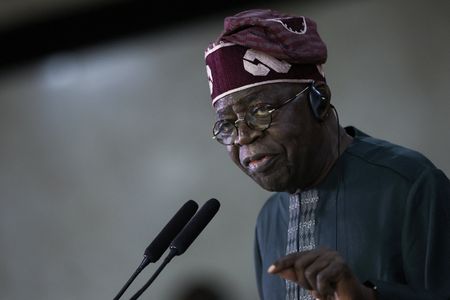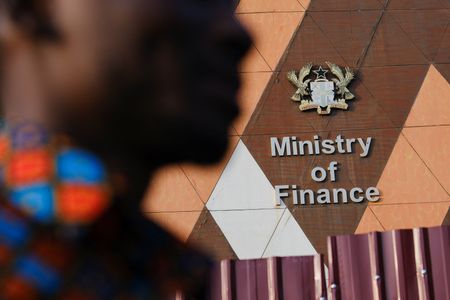By Gertrude Chavez-Dreyfuss
NEW YORK (Reuters) -The U.S. dollar slid to two-week lows against the yen on Wednesday after data showed private-sector jobs in the world’s largest economy contracted last month, boosting expectations the Federal Reserve will cut interest rates two more times this year.
Against the euro and sterling, the dollar fell to one-week troughs in the wake of the jobs data.
Data showed that U.S. private employment shrank by 32,000 jobs last month after a downwardly revised 3,000 decline in August, according to the ADP National Employment Report on Wednesday. Economists polled by Reuters had forecast private employment increasing 50,000 following a previously reported 54,000 advance in August.
“The job situation seems to just be getting a little bit worse, data point after data point,” said Erik Bregar, director, FX & precious metals risk management at Silver Gold Bull in Toronto.
“The ever-weakening U.S. jobs market is the big story. And with the official data sources on hold because of the shutdown, some people might like it actually because those data sources haven’t been very reliable lately.”
U.S. rate futures have priced nearly 50 basis points of cuts this year following the ADP data, from about 43 bps of easing on Tuesday, with market-implied odds of around 99% for an October rate move, according to LSEG data.
The jobs data followed a mixed reading for the Bureau of Labor Statistics’ Job Openings and Labor Turnover Survey, or JOLTS, on Tuesday. The report showed U.S. job openings increased marginally in August while hiring declined, consistent with a softening labor market.
The ADP report, jointly developed with the Stanford Digital Economy Lab, gained more attention from investors seeking fresh clues on the labor market as the Labor Department’s more comprehensive and closely followed employment report for September will not be published on Friday.
The private sector jobs report came amid a U.S. government shutdown, which commenced hours after the Senate rejected a short-term spending measure that would have kept government operations afloat through November 21.
Senate Republican Leader John Thune said the chamber would vote again on the House-passed measure on Wednesday.
“We are concerned with the government shutdown, which also does not bode well for the buck,” said Juan Perez, director of trading at Monex USA in Washington.
“The dollar has few reasons to remain a beacon of strength and reliability when the American government is closed and there is evidence presented that Americans are struggling to find jobs.”
In afternoon trading, the dollar fell 0.6% against the yen to 147.07 yen, after earlier falling to its weakest since September 17. The greenback was flat against the Swiss franc at 0.7967 franc.
The greenback also fell to a one-week low against the euro, which was last up 0.1% at $1.1738.
Sterling also rose to a one-week high versus the dollar, and was last up 0.3% at $1.3487.
The dollar index, which tracks the U.S. currency against six major peers, fell to a one-week trough, and was last down 0.2% at 97.68. The broader markets bore a few hallmarks of safe-haven buying, giving low-yielding currencies such as the Japanese yen a bid, while U.S. Treasuries and gold held firm.
U.S. President Donald Trump warned congressional Democrats on Tuesday that letting the federal government shut down would allow his administration to take “irreversible” actions including closing programs important to them.
The U.S. Labor and Commerce departments said their statistics agencies would halt data releases in the event of a partial shutdown. That includes Friday’s scheduled nonfarm payrolls release, considered key in determining whether a Fed rate cut is likely at the end of this month.
The length of any shutdown may be key for markets, as the Fed’s next policy decision on October 29 remains weeks away.
In contrast, traders are placing a roughly 40% chance that the Bank of Japan will raise interest rates this month. The central bank’s quarterly “tankan” corporate sentiment survey on Wednesday showed confidence among big Japanese manufacturers improved for the second straight quarter and firms maintained their upbeat spending plans.
BOJ officials have tilted more hawkish in recent days, including formerly dovish board member Asahi Noguchi, who said on Monday that the need for policy tightening was increasing more than ever.
Currency
bid
prices at
1
October
06:55
p.m. GMT
Descripti RIC Last U.S. Pct YTD Pct High Low
on Close Change Bid Bid
Previous
Session
Dollar 97.678 97.837 -0.15% -9.97% 97.885 97.4
index 59
Euro/Doll 1.1738 1.1733 0.04% 13.38% $1.1779 $1.1
ar 716
Dollar/Ye 147.06 147.98 -0.55% -6.47% 148.205 146.
n 595
Euro/Yen 172.64 173.57 -0.54% 5.77% 173.91 172.
33
Dollar/Sw 0.7968 0.7964 0.05% -12.2% 0.7989 0.79
iss 29
Sterling/ 1.3484 1.3448 0.29% 7.84% $1.3527 $1.3
Dollar 435
Dollar/Ca 1.3939 1.392 0.14% -3.06% 1.3957 1.39
nadian 07
Aussie/Do 0.6616 0.6614 0.06% 6.95% $0.6629 $0.6
llar 59
Euro/Swis 0.9352 0.9343 0.07% -0.44% 0.9372 0.93
s 36
Euro/Ster 0.8702 0.8725 -0.26% 5.19% 0.8742 0.86
ling 91
NZ 0.5816 0.5795 0.42% 4% $0.5831 0.57
Dollar/Do 87
llar
Dollar/No 9.9047 9.9837 -0.79% -12.85% 10.0021 9.90
rway 16
Euro/Norw 11.6276 11.7153 -0.75% -1.2% 11.742 11.6
ay 258
Dollar/Sw 9.3613 9.4038 -0.45% -15.03% 9.4257 9.35
eden 33
Euro/Swed 10.9937 11.0381 -0.4% -4.11% 11.0645 10.9
en 93
(Reporting by Gertrude Chavez-Dreyfuss; Additional reporting by Amanda Cooper in London and Kevin Buckland in Tokyo; Editing by Jamie Freed, Jacqueline Wong, Ed Osmond and Andrea Ricci)











